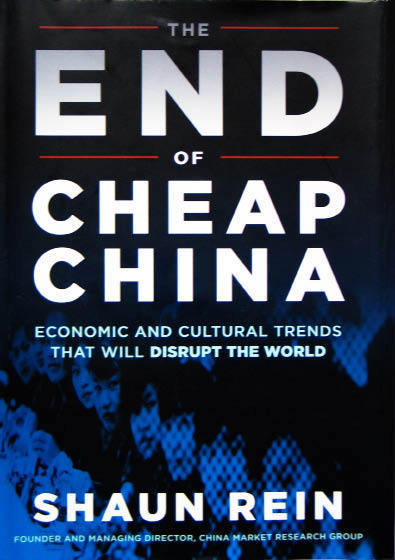Get Ready for the Wave

Title: The End of Cheap China: Economic and Cultural Trends That Will Disrupt the World
Author: Shaun Rein
US$ 24.95
224 pages, hardback
Published by John Wiley & Sons, Inc., 2012
Right now, The End of Cheap China is a huge and ominous wave crashing down on the shoreline. Or so says Shaun Rein in the conclusion to the overview of China he has been forming for more than a decade of involvement in the country. The End of Cheap China, he adds, is ready to crush those companies that refuse to budge from their traditional approaches and practices. But this stark warning is just one side of the coin, the obverse of which, where the company understands and adapts to the Chinese wave, is eminently positive.
Though what previously fueled China’s growth – the ability to produce low-cost goods largely due to its huge army of cheap labor – is evaporating, a new opportunity has appeared in the form of the growing domestic market. Rein introduces us to the individuals putting pressure on manufacturers to raise salaries. They are the factory workers and managers who are demanding higher wages and better working conditions, well aware of the power they hold over their employers and playing company against company, heading to whoever offers the best deal.
Rather than focusing just on the end of cheap Chinese labor and the cheap goods flooding out of the country as its title suggests, the subject of The End of Cheap China is much broader, giving a synopsis of the future of the Chinese market and its implications in the near future. For one thing, these ever more demanding employees aren’t just a threat to manufacturers’ bottom line – they are also part of a population with increasing spending clout. This book helps the reader understand the hugely complicated world Chinese shoppers live in, their means, fears, and aspirations.
For anybody interested in tapping into the much-lauded rising consumer masses in China this is a must read. It warns against many dangerous Western assumptions that just don’t work in China.
For example, the mid-range brands that attract so many of the West’s middle class don’t do well here. Some Chinese people want to show off their new found wealth with ostentatious luxury goods – leather bags and the latest smart phones – and they’ll skimp in other areas of consumption to buy them. The goods that do well are those at either extremes of the price scale. His advice to foreign companies looking to enter the Chinese market, therefore, is to present their goods as a luxury item with a price tag to match.
The book also warns against the mistake Mattel made when it opened its six-story Barbie flagship store in Shanghai. The clothes were designed for the Chinese market, but Chinese women just weren’t buying the low-cut blouses on offer and the store closed two years later.
Rein puts a lot of emphasis on women as the consumers to really focus on, and the book seems to be populated mainly by women. Personal stories about real individuals fleshing out the generalizations he makes about this changing sector of society. Each character comes from hugely divergent backgrounds, but they all have one thing in common – ambition and determination to create more successful lives for themselves.
Among them is Melanie, a white-collar businesswoman. Young upwardly mobile women like Melanie are one element of the market for imported goods bubbling up in China: Typically for this generation, her parents house and feed her. With few responsibilities outside of work she isn’t concerned with saving, changing her handset every nine months. And her credit card allows her to buy the latest iPhone straight away instead of saving for two months.
As the book progresses, Rein tackles China’s biggest weaknesses in its prospective prosperity – namely lack of adequate housing, corruption, food safety issues, and the education system – explaining the intricate challenges of each of these widely reported topics.
The influence of “the end of cheap China” beyond China’s borders is also explored, challenging simplistic media perceptions of the country. Rein is particularly persistent in criticizing Paul Krugman’s claims that the weakness of the Chinese yuan is keeping Chinese exports cheap and stealing American jobs. His main point is that when Chinese exports are no longer cheap, the jobs won’t return to the U.S. but flow southward to countries like Vietnam.
He explains China’s more active involvement in the world – fueled by the need for raw materials and technological and managerial expertise. The discussion delves into China’s involvement in Africa, about the road it’s building, and what China is asking of, or not asking of, the continent. It looks at mergers and acquisitions and reassures companies not to fear being bought, as Chinese multinationals don’t want to change them or strip them for parts – they want knowledge.
Overall, Shaun Rein is optimistic about “the end of cheap China.” And though he certainly does not ignore the darker aspects of China’s past and present – the “cultural revolution,” prostitution existing through local corruption, immoral methods of cutting corners in the food industry – he certainly is inclined to think the best of and defend his adopted home. His love of China hinted at during his descriptions of the country and in the tales of his personal experiences of it is almost palpable, and his writing is full of enthusiasm for the possibilities that lie ahead.

